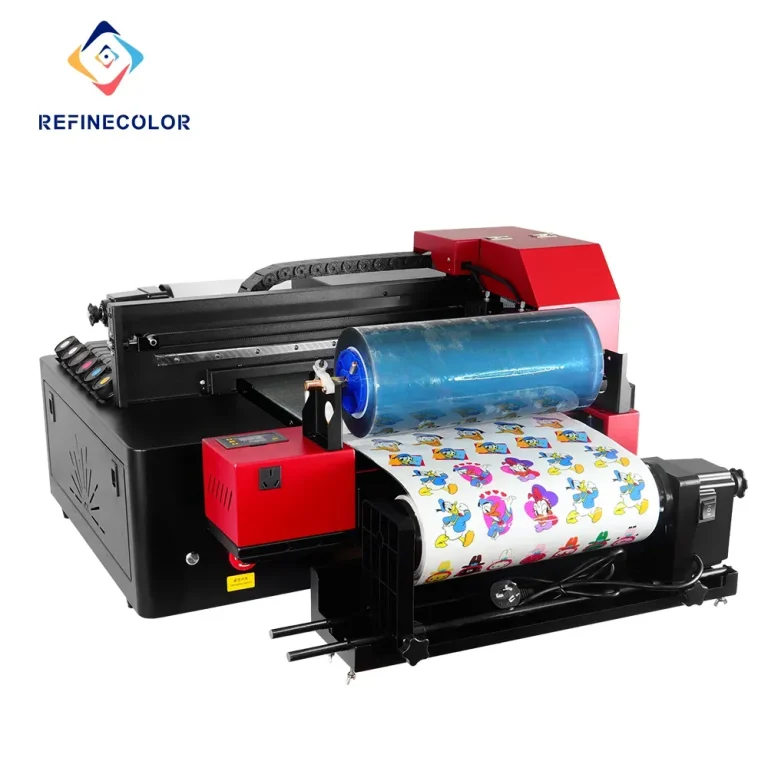UV DTF Printing: Unlocking Its Full Potential Today
UV DTF printing, an innovative breakthrough in the realm of custom printing methods, is making waves across various industries. This advanced technique harmoniously combines the strengths of UV printing technology with the efficiency of the Direct to Film method, resulting in stunning, high-resolution prints that can be applied to an array of surfaces. With its remarkable ability to produce vivid colors and durable results, UV DTF printing is quickly becoming a preferred choice for businesses seeking sustainable printing solutions. From textiles to metal and plastics, this versatile process opens the door to exciting UV DTF applications, allowing for a diverse range of products to be customized to perfection. As the demand for personalized items grows, understanding the benefits and potential of UV DTF printing is essential for staying competitive in today’s market.
The emergence of UV DTF printing represents a significant leap forward in graphic reproduction techniques, attracting attention for its dynamic capabilities. Sometimes referred to as Direct to Film UV printing, this method uniquely integrates film transfer technology with ultraviolet ink curing to achieve unrivaled print quality. It is renowned for its versatility across various materials, making it a sought-after option in custom printing endeavors. Notably, the expanding scope of applications illustrates how this technique can cater to the needs of a rapidly evolving marketplace, particularly in the realm of personalized products. As companies continue to explore eco-friendly initiatives and innovative solutions in their printing processes, the impact of UV DTF technology on sustainable printing practices becomes increasingly pivotal.
Understanding the Fundamentals of UV DTF Printing
UV DTF printing is a cutting-edge technology that merges traditional UV printing techniques with the versatility of film transfer methods. This process begins by printing high-quality, vibrant images onto a specially coated film using UV inks. Once the printing is completed, the film is exposed to ultraviolet light, which cures the ink and ensures that the image is durable and resistant to wear. What sets UV DTF apart from other printing methods is its capability to produce impressive results on a multitude of materials, from textiles and wood to plastics and metals.
The rise of UV DTF printing reflects a growing demand for innovative, high-resolution prints that can withstand the rigors of daily use without losing vibrancy. This method not only meets the needs of various industries but also allows for significant customization, setting it apart in the realm of custom printing methods. As businesses strive for uniqueness and quality in their products, the advantages of UV DTF printing become increasingly relevant, attracting attention across multiple market sectors.
Advantages of Choosing UV DTF Over Traditional Methods
One of the primary advantages of UV DTF printing is its superior color quality. By utilizing UV inks that cure instantly under ultraviolet light, prints tend to showcase more vibrant colors and exceptional detail compared to traditional printing methods. This is particularly beneficial for designs that require rich color saturation and high-resolution outputs. Customers are increasingly drawn to prints that are not only visually striking but also endure the test of time, making UV DTF an ideal solution for modern printing needs.
Additionally, the versatility of UV DTF printing cannot be overstated. Whether it’s promotional items, fashion textiles, or custom gifts, this printing technique excels in adapting to various substrates. Businesses can expand their product offerings without investing in multiple printing systems, which enhances operational efficiency. This flexibility is crucial as the market evolves, allowing companies to remain competitive while catering to diverse customer preferences.
The Role of Technology in Advancing UV DTF Printing
The continuous advancement of technology within the UV DTF printing domain has significantly influenced print quality and efficiency. New innovations, such as smart print heads and adaptive calibration systems, have paved the way for printing on intricate surfaces, thereby broadening the application spectrum. Smart print heads adjust droplet size and placement accurately, contributing to a higher resolution and more vivid output. This precision is key for industries that prioritize quality in their final products.
Moreover, with automated feeding systems designed to streamline workflow, UV DTF printing is evolving into a quicker, more efficient process. These systems not only minimize manual input but also allow for quick setup and adjustment when transitioning between different printing media. This technological prowess directly impacts production capacity, enabling businesses to meet larger orders and customer demands without compromising quality.
Exploring the Diverse Applications of UV DTF Printing
UV DTF printing is making waves across various industries due to its adaptability. As businesses look for unique ways to engage consumers, the application of this printing method extends beyond conventional products. Customizable promotional items, for instance, benefit immensely from the vivid colors and designs enabled by UV DTF technology. This allows businesses to create standout products that capture attention and drive brand recognition.
In the field of textiles, UV DTF opens up opportunities for personalization like never before. The ability to print directly onto fabrics means that both fashion designers and home décor producers can create bespoke designs that cater to individual tastes. Whether it’s a uniquely designed jacket or custom curtains, the potential for creativity and customization in the textiles sector expands considerably with UV DTF printing.
Sustainability in UV DTF Printing Practices
As sustainability increasingly shapes consumer decision-making, UV DTF printing is rising to the occasion. Manufacturers are adopting eco-friendly inks that cater to the growing demand for sustainable printing solutions without sacrificing quality. These inks are formulated to reduce harmful emissions and waste products, making them less detrimental to the environment compared to traditional solvent-based inks. This proactive approach aligns with the values of consumers who prefer brands that demonstrate an environmental commitment.
In addition to eco-friendly inks, energy-efficient technologies are being integrated into modern UV DTF printers. By utilizing components designed to minimize energy consumption during the printing process, businesses can reduce their overall carbon footprint. This shift not only reflects a commitment to sustainability but also results in cost savings that can enhance profitability. As the printing industry embraces greener practices, UV DTF stands out as a method that prioritizes both quality and environmental responsibility.
Future Trends Transforming the UV DTF Printing Market
The UV DTF printing market is poised for remarkable growth in response to evolving consumer needs. One significant trend is the increasing demand for on-demand and customizable printing solutions. As consumers continue to seek unique products tailored to their preferences, UV DTF printers offer the perfect solution to deliver high-quality prints quickly and efficiently. This trend towards personalization is reshaping how businesses approach product offerings, and UV DTF is at the forefront of this transformation.
Another trend is the integration of UV DTF printing with e-commerce platforms. The rise of online shopping has created a demand for tools that allow consumers to design and order personalized products from the comfort of their homes. By harnessing UV DTF technology, companies can provide seamless and engaging online experiences, where customers can visualize their custom products before purchasing. This convergence of technology and consumer preference indicates a promising future for the UV DTF printing industry as it aligns with modern shopping behaviors.
Frequently Asked Questions
What are the advantages of using UV DTF printing for custom designs?
UV DTF printing offers several advantages for custom designs, including superior color quality, versatility across multiple materials, and enhanced durability of prints. The cured UV inks provide vibrant colors and fine details that stand out on various substrates such as textiles, plastics, and metal, making it an ideal choice for businesses seeking high-quality custom printing methods.
How does UV DTF printing compare to traditional printing methods?
Unlike traditional printing methods, UV DTF printing combines the benefits of UV printing technology with direct-to-film processes, enabling prints to adhere better and withstand harsh conditions. This method allows for printing on uneven surfaces and materials where standard printing techniques may fail, resulting in more diverse application opportunities for businesses.
What types of products can be created using UV DTF applications?
UV DTF applications are versatile, allowing for a wide range of products such as promotional items, customized textiles, personalized gifts, and signage. This custom printing method is especially popular in fashion, home decor, and promotional goods due to its ability to produce high-resolution designs that are both durable and visually striking.
Is UV DTF printing an environmentally sustainable option?
Yes, UV DTF printing is becoming an increasingly sustainable printing option. Many UV DTF printers utilize eco-friendly inks that reduce environmental impact, along with energy-efficient technologies that minimize carbon footprint during production. This focus on sustainability aligns with industry trends toward greener printing practices.
What advancements are being made in UV DTF printing technology?
Recent advancements in UV DTF printing technology include the development of smart print heads that enhance image resolution, automated feeding systems for greater efficiency, and adaptive calibration techniques that optimize print quality on various substrates. These innovations are driving growth and improving the capabilities of UV DTF printers.
How can businesses leverage UV DTF printing for marketing purposes?
Businesses can leverage UV DTF printing for marketing by creating unique promotional products that capture customer attention, offering personalized gifts that cater to individual consumer preferences, and providing on-demand printing solutions for customized orders. By utilizing this innovative printing technology, companies can enhance brand visibility and engage customers more effectively.
| Key Aspects | Description |
|---|---|
| Understanding UV DTF Printing | A modern printing method combining direct UV printing with film transfer for vibrant, durable prints on multiple surfaces. |
| Benefits of UV DTF Printing | Superior color quality, versatility on various substrates, durability against scratches and fading, and eco-friendly inks. |
| Technological Advancements | Smart print heads and automated systems enhance operational efficiency and print quality. |
| Applications | Used in promotional products, textiles, and personalized gifts, increasing brand visibility and consumer engagement. |
| Sustainability | Integration of eco-friendly inks and energy-efficient technologies reduces environmental impact. |
| Market Growth | The UV printing market, including UV DTF, is expected to grow substantially due to high demand for customization. |
| Resources for Success | Educative webinars and comprehensive guides support businesses in optimizing their use of UV DTF printing. |
Summary
UV DTF printing is a noteworthy innovation in the field of printing technology, merging efficiency, versatility, and sustainability. Its ability to deliver vibrant, high-resolution prints on diverse substrates has captivated businesses pursuing durable solutions. As we progress, UV DTF printing is set to redefine industry standards, fostering exciting opportunities for creativity and customization. By capitalizing on its strengths and remaining informed about market trends, companies can stand out in a competitive landscape, ensuring growth and success.






